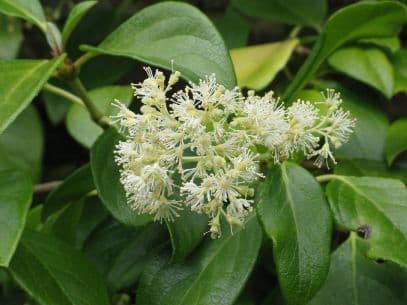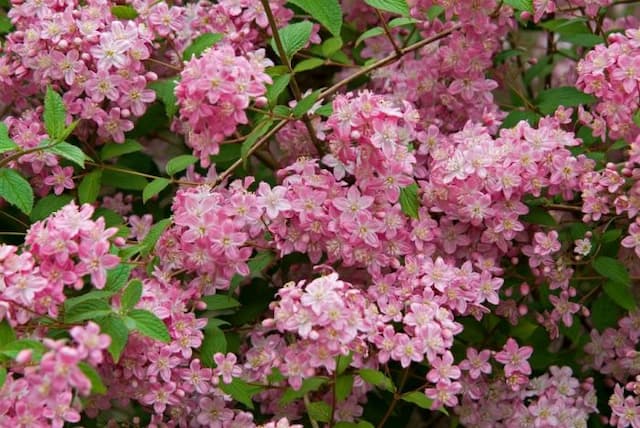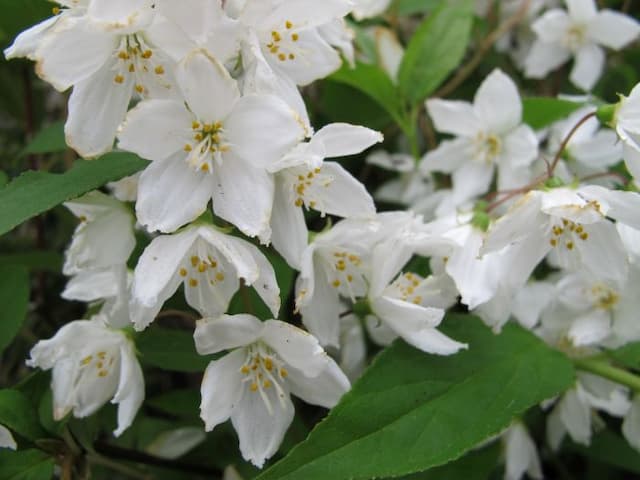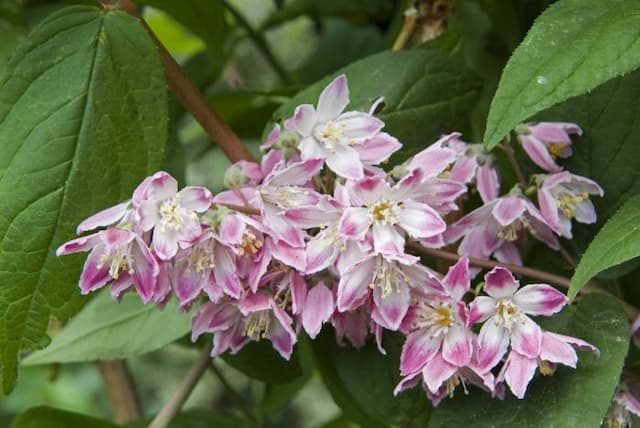Panicle Hydrangea Hydrangea paniculata Diamant Rouge = 'Rendia' (PBR)
ABOUT
Hydrangea paniculata 'Diamant Rouge', commonly known as the panicle hydrangea, is a visually stunning plant with a striking appearance. The most notable feature of this cultivar is its large, conical flower clusters which bloom in abundance. These flowers present a dramatic transformation throughout the season. They begin as a soft white and gradually mature to a rich, raspberry red, creating a two-toned effect that is quite breathtaking. The blossoms hold well on strong stems and are complemented by deep green leaves which provide a lush backdrop for the vibrant flower panicles. Overall, the 'Diamant Rouge' has a dense, bushy appearance, making it a spectacular addition to gardens where a visual impact is desired. The flowers of this hydrangea can be enjoyed in the landscape from summer into fall, providing long-lasting color and interest.
About this plant
 Names
NamesSynonyms
Diamant Rouge Hydrangea, Diamond Rouge Hydrangea, Panicled Hydrangea, Panicle Hydrangea.
Common names
Hydrangea paniculata 'Diamant Rouge', Hydrangea paniculata 'Rendia'.
 Toxicity
ToxicityTo humans
The most common common name of Hydrangea paniculata Diamant Rouge = 'Rendia' (PBR) is simply 'hydrangea'. Hydrangeas, including 'Diamant Rouge', are considered to have low toxicity to humans. Ingesting parts of the plant can lead to gastrointestinal distress, characterized by symptoms such as nausea, vomiting, and diarrhea. Additionally, hydrangeas contain compounds that can release cyanide in the stomach, but poisoning is rare and typically happens only if large quantities are consumed. Ingesting hydrangea should be avoided, and if symptoms arise, medical attention should be sought.
To pets
The most common common name of Hydrangea paniculata Diamant Rouge = 'Rendia' (PBR) is also 'hydrangea'. Hydrangeas are toxic to pets, including dogs, cats, and horses. The plant contains compounds that can release cyanide when digested. Symptoms of hydrangea poisoning in pets may include vomiting, diarrhea, lethargy, and depression. In severe cases, ingestion can lead to cyanide intoxication, which is serious and can be life-threatening. If a pet consumes any part of a hydrangea, it is crucial to contact a veterinarian immediately.
 Characteristics
CharacteristicsLife cycle
Perennials
Foliage type
Deciduous
Color of leaves
Green
Flower color
Pink
Height
6-8 feet (1.8-2.4 meters)
Spread
4-6 feet (1.2-1.8 meters)
Plant type
Shrub
Hardiness zones
3-8
Native area
Asia
Benefits
 General Benefits
General Benefits- Attractive Flowers: Produces large, showy panicles of flowers that transition from white to pink to red, adding vibrant colors to the garden.
- Seasonal Interest: Offers multi-season visual interest from spring blooms to fall foliage and dried winter flower heads.
- Drought Tolerance: Once established, it's fairly drought-resistant, reducing the need for frequent watering.
- Easy to Grow: Adaptable to a range of soil types and conditions, making it suitable for a variety of garden settings.
- Pollinator Friendly: Attracts bees, butterflies, and other pollinators, promoting biodiversity.
- Landscape Versatility: Can be used for mass planting, as a focal point, in borders, or as a hedge.
- Low Maintenance: Requires minimal pruning and care, making it ideal for gardeners of all skill levels.
- Cold Hardy: Tolerates cold temperatures, which makes it suitable for growing in cooler climates.
- Long Blooming Period: Flowers for a longer period than many other shrubs, providing extended garden interest.
- Compact Size: Its relatively small size makes it a good choice for urban or smaller gardens.
 Medical Properties
Medical PropertiesThis plant is not used for medical purposes.
 Air-purifying Qualities
Air-purifying QualitiesThis plant is not specifically known for air purifying qualities.
 Other Uses
Other Uses- Floral Arrangements: Hydrangea paniculata can be used in fresh or dried floral arrangements to add volume and a touch of color, lasting well beyond their outdoor blooming period.
- Photography Prop: The large, showy blooms provide a romantic and colorful backdrop for garden photography or portrait sessions.
- Artistic Inspiration: Artists may draw inspiration from the flower's shape and gradients for paintings, drawings, or textile designs.
- Event Decor: Branches of the Hydrangea paniculata can be used in large displays for events such as weddings or parties to create a dramatic and upscale atmosphere.
- Educational Tool: This plant can be used in horticulture and botany education for teaching about plant identification, growth patterns, and pruning techniques.
- Garden Themes: Can be a central feature of a "pink garden" theme where various shades of pink flowers create a monochromatic design.
- Habitat Support: May be planted to support local wildlife, providing shelter and potential nesting sites for birds.
- Natural Dyes: The blooms could potentially be used to create natural dyes for fabrics, though this is not a common practice.
- Gastronomy: Some avant-garde chefs might use the blooms as an edible decoration for high-end plates, though they are not generally considered edible.
- Cultural Symbol: Can be planted as a symbol of abundance and grace in thematic gardens, according to the language of flowers.
Interesting Facts
 Feng Shui
Feng ShuiThe Hydrangea is not used in Feng Shui practice.
 Zodiac Sign Compitability
Zodiac Sign CompitabilityThe Hydrangea is not used in astrology practice.
 Plant Symbolism
Plant Symbolism- Gratitude: The Hydrangea is often given as a thank you gesture, symbolizing appreciation and heartfelt gratitude due to its lavish and abundant flower heads.
- Understanding: It represents a deep understanding between people, possibly because of its dense and multifaceted blooms that suggest complexity.
- Heartfelt Emotions: The lush and extravagant look of the Hydrangea expresses the abundance of emotions, often used to convey genuine emotion and love.
- Frivolity: In some cultures, the Hydrangea symbolizes frivolity or boastfulness. This stems from the Victorian era where the plant's ability to produce many flowers, but very few seeds, was seen as a sign of superficiality.
- Apology: These flowers are sometimes used to express regret or to ask for forgiveness, again possibly due to the Victorian symbolism where its lack of seeds represented boastfulness and thus, a need to make amends.
 Water
WaterThe Diamant Rouge Hydrangea should be watered thoroughly to ensure the soil is moistened to a depth of 8 inches, which typically requires about 1 to 2 gallons of water, depending on the size of the plant and the environmental conditions. During the growing season, watering should be done once a week, but this should be adjusted depending on rainfall and temperature, with more frequent watering in hot, dry spells. Overhead watering is not recommended, as it can encourage leaf diseases; instead, apply water directly to the base of the plant.
 Light
LightThe Diamant Rouge Hydrangea thrives in a location with morning sun and afternoon shade, especially in regions with hot summers. It can withstand full sun exposure in cooler climates but prefers a spot that offers some protection from intense midday rays. An ideal spot is one that provides bright light for a few hours a day but shields the plant from the harshest sunlight.
 Temperature
TemperatureDiamant Rouge Hydrangeas are hardy and can withstand a wide range of temperatures, from winter lows down to about 0 degrees Fahrenheit to summer highs well into the 90s. They grow best at temperatures between 65 and 75 degrees Fahrenheit. It's crucial to protect them from spring frosts that can damage new growth.
 Pruning
PruningPruning the Diamant Rouge Hydrangea is important to maintain its shape and size and to remove any dead or weak branches which can encourage better blooms. Pruning should be done in late winter or early spring before new growth starts. Cut back the plant by about one-third of its height, focusing on removing older stems to allow room for new growth.
 Cleaning
CleaningAs needed
 Soil
SoilThe best soil mix for Hydrangea paniculata 'Diamant Rouge' should be rich in organic matter, well-draining, and have a pH range of 5.5-6.5. A mix of loam, peat, and compost in equal parts can provide the needed structure and nutrients.
 Repotting
RepottingPanicle hydrangeas like 'Diamant Rouge' are typically repotted every 2-3 years or when they outgrow their current container. They prefer to be slightly root-bound, so avoid over-potting.
 Humidity & Misting
Humidity & MistingHydrangea paniculata 'Diamant Rouge' prefers moderate humidity levels. Consistent humidity levels, rather than extremes, will support its growth but typically are not a crucial factor outdoors where the plant thrives best.
 Suitable locations
Suitable locationsIndoor
Use bright, indirect light and keep soil moist for 'Diamant Rouge'.
Outdoor
Choose a spot with morning sun and afternoon shade for the 'Diamant Rouge'.
Hardiness zone
3-8 USDA
 Life cycle
Life cycleHydrangea paniculata Diamant Rouge, commonly known as the Panicled Hydrangea, begins its life cycle as a dormant seed, which, when exposed to appropriate spring temperatures and moisture, germinates and sprouts into a seedling. As it matures, it develops a root system and foliage, gradually forming a woody shrub with sturdy stems. In the growing season, typically in early summer, it enters the vegetative stage, producing large, lush green leaves. The shrub progresses to the flowering stage in mid to late summer, producing striking pyramidal clusters of flowers that transition from white to deep pink as they age. After the blooming period, seed heads may form, and as autumn arrives, the plant enters senescence, with leaves turning yellow and stems hardening. The Panicled Hydrangea becomes dormant during winter, with the cycle repeating annually as temperatures rise in the spring.
 Propogation
PropogationPropogation time
Spring to Early Summer
Hydrangea paniculata 'Diamant Rouge', commonly called Panicled Hydrangea, is usually propagated through softwood cuttings. This method is popular as it is relatively simple and effective. Propagation is best carried out in late spring or early summer when the plant's growth is vigorous. To propagate, a gardener would cut a 4-6 inch (10-15 cm) piece of stem that includes several leaf nodes from a healthy plant, ensuring that at least one pair of leaves remains at the top. The lower leaves are removed, and the cut end is dipped in rooting hormone to encourage root development. The cutting is then planted in a mixture of peat and perlite or sand, and kept moist and under indirect light until roots have developed, which typically takes a few weeks. Once the cutting has rooted, it can be transplanted into a larger pot or directly into the garden.






![Rose deutzia [Yuki Cherry Blossom]](/_next/image?url=https%3A%2F%2Fplants-admin.emdemapps.com%2Fimages%2Fplants%2F%2Fimages%2F604b6510a383a.png&w=640&q=75)
![Hydrangea [Hot Chocolate]](/_next/image?url=https%3A%2F%2Fplants-admin.emdemapps.com%2Fimages%2Fplants%2F%2Fimages%2F604b5a066e3bd.png&w=640&q=75)
![Hydrangea [Blackberry Pie]](/_next/image?url=https%3A%2F%2Fplants-admin.emdemapps.com%2Fimages%2Fplants%2F%2Fimages%2F604b56e2abc1d.png&w=640&q=75)
